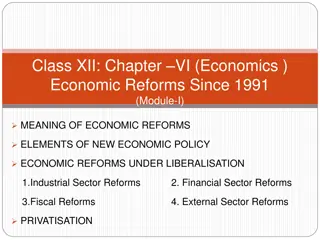Overview of the Lebanese Industrial Sector: Insights and Analysis
The Lebanese industrial sector in 2007 saw 4,033 establishments with at least 5 workers. A detailed study was conducted to assess performance, gather data on various aspects, and initiate a new industrial strategy. The database for the survey was comprehensive, including information from multiple sources. The study focused on key areas such as industrial output, workforce profile, assets, and more. The main features highlighted the number of industries and exclusions based on certain criteria, providing a snapshot of the sector's landscape.
Download Presentation

Please find below an Image/Link to download the presentation.
The content on the website is provided AS IS for your information and personal use only. It may not be sold, licensed, or shared on other websites without obtaining consent from the author. Download presentation by click this link. If you encounter any issues during the download, it is possible that the publisher has removed the file from their server.
E N D
Presentation Transcript
THE LEBANESE INDUSTRIAL SECTOR : FACTS AND FINDINGS 2007 Beirut, 2010 1
Main Objectives In 2008, the Ministry of Industry, with the support of the Association of the Lebanese Industrialists (ALI) and the UNIDO, launched a new study to assess the industrial sector s performance. The study s main objective was to : 1. Conduct a census covering the large and medium industrial establishments (5 workers and more) 2. Collect descriptive and quantitative data on number and location of establishments, number of persons employed, compensation of employees, value of production and sales, input costs, energy expenses, inventory, investments, etc. 3. In a second phase, and based on this data collection, the Ministry will launch a national debate to initiate a new industrial strategy 2
Database The database for the survey was prepared from different sources including information from previous surveys and from registers of the MoI, as well as from records of the Association of the Lebanese Industrialists (ALI) and other line ministries and organizations The data base was enriched by additional manufacturing establishments administered by other ministries, such as pharmaceutical products or stone quarry At the same time, the field surveyors were asked to address local authorities and to visit all industrial zones of the country 3
Outline Section 1 Main Features Section 2 Quantitative Analysis Industrial output Number of units Intermediate consumption Location Value added Size of establishments Assets Workforce and its profile Gross fixed capital formation Working area Salaries Legal status and year of establishment Adherence to a professional association 4
Number of Industries According to the 2007 census results, Lebanon s industrial sector counts 4,033 establishments, with 5 workers and more. This total excludes : 198 establishments that did not cooperate with surveyors, The Tobacco public monopoly, Public water and power establishments Construction activities. Industrial establishments registered after December 2007 Industrial establishments with less than 4 workers and with low fixed assets and sales, were considered as handicraft activities, and therefore were not included in this study. 6
Industries Location Industrial units are not evenly distributed over the Lebanese territory. However the rural areas host an important number of large industrial operators. . Mohafaza Beirut Mount North Lebanon Bekaa South Nabatiyeh Total Lebanon Lebanon Number 239 2,010 518 744 420 102 4,033 % of total 5.9% 49.8% 12.8% 18.4% 10.4% 2.5% 100.0% Average workers establishment 19 18 25 12 17 12 21 per 7
Main Industrial Activities The Lebanese industry is not diversified. 10 major branches: Group 86% of establishments Generate 90.7 % of total value added Employ 87.3% of the total workforce Achieve 94.6% of the yearly industrial investments 8
Size of Industrial Units The bulk of industrial establishments are small units. Class of workforce 5-9 workers Nb of establishments Workforce 2,081 13,756 % of total industries 10-19 workers 51.6% 1,072 16.6% 14,090 78% employ between 5 and 19 workers % of total industries 20-34 workers 26.6% 449 17.0% 11,466 Only 3% employ more than 100 workers % of total industries 35-49 workers 11.1% 146 13.8% 6,042 Industries employing more than 50 workers represent 7.1% of total establishments % of total industries 50-99 workers 3.6% 166 7.3% 11,153 % of total industries 100-249 workers 4.1% 87 13.5% 12,702 . but employ more than 45 % of the workforce % of total industries over 250 workers % of total industries TOTAL 2.2% 32 0.8% 4,033 15.3% 13,635 16.5% 82,843 9
Industrial Workforce The 4,033 industrial establishments employ a total of 82,843 workers of which: The average number of workers by unit is 21 The establishments employing from 5 to 19 workers represent 78.2% of the total number of establishments but only 33.6% of the total workforce 8,100 owners or partners 70,180 permanent employees 4,237 seasonal workers 326 outworkers Only 17% of permanent employees are females 10
Industrial Workforce by industrial activity Distribution of Workforce by Economic Activity Machinery and equipment 2.6% Other activities 12.7% Printed matter & recorded media 6.7% Food products & beverages 24.9% Rubber & plastic products 4.5% Pulp,paper & paper products 5.1% Other non-metallic mineral products 13.3% Electrical machinery and apparatus 3.8% Furniture & other manufactured goods 11.0% Fabricated metal products 9.7% Chemicals & man-made fibres 5.8% 11
Built Operating Area Average built area per establish . The total built operating area is estimated at around 11.6 million m2, with an average built area per enterprise of 2,877 m2 Average worker per establish. Average built area per worker Workforce by Class 7 806 115 5-9 However, 62 % of the industrial enterprises are operating in a space of around 915,000 m2 (364 m2 per unit) 13 2,121 10-19 163 26 3,817 20-34 147 41 3,570 87 35-49 78 establishments (1.9% of total establishments) occupying the largest areas (more than 20,000 m2) are using 46% of the total built operating area with an average space of68,355 m2 67 7,286 50-99 109 146 22,234 100-249 152 426 70,962 250 167 21 2,877 Total 137 12
Year of Establishment The Lebanese industrial establishments are considered as new industries. 61.7% of the 4,033 establishments were established between 1990 and 2007. Distribution of Establishments by Year of establishment 1950-1959 2.5% Before 1950 2.0% 2000-2010 29.9% 1960-1969 5.9% 1970-1979 12.0% 1980-1989 15.9% 1990-1999 31.8% 13
Legal Status and Membership in Professional Associations 55% of industrial establishments are registered as individual establishments 45% of Lebanese industrialists are not registered at any professional or regional business association 20% are limited liability companies (S.A.R.L.) 58 % of establishments employing less than 10 workers are not members of any professional association This figure is 6% for companies employing more than 100 workers 11% are general partnerships (en commandite simple) 9% are limited companies (S.A.L.) 4% are limited partnerships The most reluctant establishments to participate in professional associations are those involved in construction materials Less than 1% of establishments are registered in other legal form (cooperatives, limited by shares ) 14
Industrial Output Highlights The total industrial output for the 4,033 industrial establishments reached USD 6.8 billion in 2007 Main components of the output : Sales from own production: 93.5% Average output per enterprise: USD 1,686,162 compared to USD 542,326 in 1998 Income from industrial and non industrial services: less than 1% Output per worker: USD 82,087 Variations in stocks for finished products or in progress: 2.7% Largest share in total output Food and beverage : 25.7% Other non-metallic mineral products : 11.7% Metal products: 10.9% Value of electricity generated for own consumption: 2.8% of the total output 16
Intermediate Consumption USD 4.7 billion Total intermediate consumption (Out of which ) Expenditures on raw materials and processed inputs 85.30% Stock variation -3.30% Share of expenditure on petroleum products for own production of electricity 4.10% Share of expenditure on electricity (from EDL) 1.30% Share of expenditure on energy products for production 2.70% Share of expenditure on maintenance 2.40% Share of other expenditures 7.50% 17
Value Added Total industry value added: USD 2.1 billion in 2007 Ratio of value added to output: 30.4% Ratio of value added to output differed according to economic activity. Lowest value: coke and refined petroleum products (4.9%) Highest value: the mining and quarrying (55.2%) Average value-added per worker equaled USD 24,927 Highest value: electrical machinery and apparatus sector (USD 61,786) compared to (USD 11,749) in the clothing sector and (USD 26,987) in the food and beverage industry Ratio of value added to output varied according to the size of enterprises. Enterprises employing more than 250 workers had the greatest contribution to total value-added (26.2%). This contribution was higher than their share of output (21.8%) 18
IndustrialActivity and Industrial Gross Margin In (000) USD 6,800,292 6,360,332 In % of industrial output 100% In % value- added Output 93.5% Value of goods produced Services (industrial and non-industrial) 0.9% 63,624 Intermediate Consumption 4,735,290 69.5% 57.1% 5.6% Net raw material Electricity, energy products Services and other operating costs 3,882,518 382,808 6.9% 469,963 2,065,002 548,203 299,642 158,169 Value Added 30.4% Wages Depreciation Interest Gross industrial margin 8.1% 4.4% 2.3% 26.5% 14.5% 7.7% 1,058,988 15.6% 51.3% 19
Salaries Total salaries (including social contributions): USD 548 million Average salary of a permanent employee: USD 7,492 Salaries varied by enterprise size. Average salary per employee is lowest in the small enterprises (USD 5,895) and highest in larger ones (USD 9,494) Salaries varied by region. The lowest average salary per employee is in Nabatiyeh (USD 4,580) and the highest is in Mount Lebanon (USD 8,039) Salaries are not homogeneous across economic activities Salary per employee is lower than average in the food and beverage (USD 6,959), furniture (USD 6,561) and clothing (USD 5,131) Salary per employee is higher than the average in the other non- metallic mineral products (USD 7,876), the printed matter and recorded media (USD 8,722) and electrical machinery and apparatus (USD 8,220) 20
Fixed Assets At the end of 2007, total industrial fixed assets are estimated at USD 4 billion out of which : Land: 19.8% Buildings and other construction: 24.3% Transport equipment : 4.0% Computers and software: 1.2% Machinery and equipment: 45.5% Other fixed assets: 5% 21
Fixed Assets by Type of Investment Distribution of Fixed Assets by type Environmental equipment 0.1% Computers 1.2% Land 19.8% Others 5.0% Vehicles 4.0% Buildings 24.3% Machinery 45.5% 22
Fixed Assets by Region Bekaa Nabatiyeh Total Value assets (000)USD 793,286 973,298 Beirut Mount Lebanon North Lebanon South Lebanon 2.40% 4.10% 2.90% 3.60% 4.90% 4.80% 56.20% 58.60% 63.50% 57.40% 81.20% 64.20% 22.10% 13.30% 18.90% 9.40% 5.70% 7.20% 3.20% 5.20% 2.70% 7.70% 2.00% 6.50% 15.60% 18.20% 11.30% 19.50% 5.80% 15.90% 0.40% 0.70% 0.70% 2.30% 0.30% 1.40% 100% 100% 100% 1,818,707 100% 100% 100% Land Building Machinery Vehicles Computers Environment al equipment Other Total value of assets (000) USD Total Output (000) USD 161,135 46,953 5,145 8.60% 137,619 2,439,769 67.20% 17.80% 702,426 1.10% 140,828 551,970 5.10% 0.10% 26,109 100% 200,196 3,998,720 492,719 4,454,395 790,777 323,046 679,913 59,441 6,800,292 7.20% 65.50% 11.60% 4.80% 10.00% 0.90% 100% Output ( % of total) 23
Gross Fixed Capital Formation Total gross fixed capital formation (G.F.C.F.) amounted to USD 296 million in 2007 Machines represent the largest share of G.F.C.F. (69.4%) and equipment for environment protection the smallest (0.1%) Small companies employing between 5 and 9 workers have the lowest share of total gross fixed capital formation (3.1%). Companies employing more than 250 workers has the highest share (36.5%) The majority of G.F.C.F. is realized in two regions: North Lebanon (43.0%) and Mount Lebanon (45.6%) 24
Gross Fixed Capital Formation Distribution of G.F.C.F. by Type of Assets Environmental equipment 0.1% Others 7.7% Land 2.6% Buildings 14.6% Computers 1.7% Vehicles 3.9% Machineries 69.4% 25
Main industrial Aggregates Nb. of establish. Workforce Nb. of employees Salaries (000$) Output (000$) Input (000$) Value-added (000$) Investment (G.F.C.F.) (000$) Economic Activity 2007 % of total 2007 % of total 2007 % of total 2007 % of total 2007 % of total 2007 % of total 2007 % of total 2007 % of total Food products & beverages 736 18.2% 20,607 24.9% 18,915 25.3% 131,632 24.0% 1,748,453 25.7% 1,192,337 25.2% 556,116 26.9% 41,104 13.9% Other non-metallic mineral products 609 15.1% 10,996 13.3% 9,824 13.1% 77,373 14.1% 797,109 11.7% 511,562 10.8% 13.8% 98,845 33.4% 285,547 Fabricated metal products 558 13.8% 8,054 9.7% 7,123 9.5% 51,334 9.4% 742,708 10.9% 577,553 12.2% 165,155 8.0% 20,806 7.0% Electrical machinery and apparatus 83 2.1% 3,182 3.8% 2,994 4.0% 24,611 4.5% 719,354 10.6% 522,750 11.0% 196,604 9.5% 13,961 4.7% Chemicals & man-made fibres 193 4.8% 4,792 5.8% 4,334 5.8% 37,992 6.9% 512,424 7.5% 357,646 7.6% 154,778 7.5% 38,349 12.9% Furniture & other manufactured goods n.e.c. 730 18.1% 9,136 11.0% 7,927 10.6% 52,007 9.5% 453,903 6.7% 266,771 5.6% 187,133 9.1% 7,833 2.6% Pulp,paper & paper products 82 2.0% 4,213 5.1% 3,892 5.2% 35,490 6.5% 399,714 5.9% 303,711 6.4% 96,003 4.6% 19,756 6.7% 253,596 5.4% 69,026 3.3% Rubber & plastic products 168 4.2% 3,692 4.5% 3,315 4.4% 21,058 3.8% 322,622 4.7% 9,760 3.3% Printed matter & recorded media 211 5.2% 5,510 6.7% 5,075 6.8% 44,258 8.1% 275,906 4.1% 161,256 3.4% 114,649 5.6% 25,855 8.7% Machinery and equipment. 105 2.6% 2,122 2.6% 1,917 2.6% 15,495 2.8% 206,129 3.0% 157,958 3.3% 48,171 2.3% 3,677 1.2% Other activities 13.8% 10,541 12.7% 12.6% 10.4% 9.1% 9.1% 9.3% 558 9,429 56,951 621,970 430,150 191,820 16,194 5.4% Total 4,033 100.0% 82,843 100.0% 74,743 100.0% 548,203 100.0% 6,800,292 100.0% 4,735,290 100.0% 2,065,002 100.0% 296,140 100.0% 26
Geographical Distribution by Caza As % of total Nb. of establish As % of total As % of total As % of total Output (000$) Caza Workforce Area m2 1,101 337 189 173 340 131 27.3% 8.4% 4.7% 4.3% 8.4% 3.2% 21,136 8,056 7,900 7,092 6,504 5,224 25.5% 9.7% 9.5% 8.6% 7.9% 6.3% 1,497,970 1,150,582 574,827 622,907 536,820 816,220 12.9% 9.9% 5.0% 5.4% 4.6% 7.0% 1,546,303 463,106 881,481 644,138 368,623 801,827 22.7% 6.8% 13.0% 9.5% 5.4% 11.8% Matn Zahleh Aaley Kessrwan Baabda Jbeil 239 334 253 76 5.9% 8.3% 6.3% 1.9% 4,509 4,069 3,335 2,567 5.4% 4.9% 4.0% 3.1% 231,399 1,218,367 243,143 1,352,733 2.0% 10.5% 2.1% 11.7% 492,719 163,375 263,885 212,024 7.2% 2.4% 3.9% 3.1% Beirut Baalbeck Saida Chouf 149 38 3.7% 0.9% 2,322 1,928 2.8% 2.3% 79,475 1,950,174 0.7% 16.8% 67,294 505,006 1.0% 7.4% Tripoli Batroun Other Cazas 673 16.7% 8,205 9.9% 1,326,342 10.6% 390,512 5.7% Total 4,033 100% 82,843 100.0% 11,600,959 100% 6,800,292 100% 27























